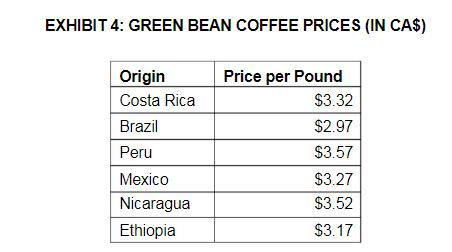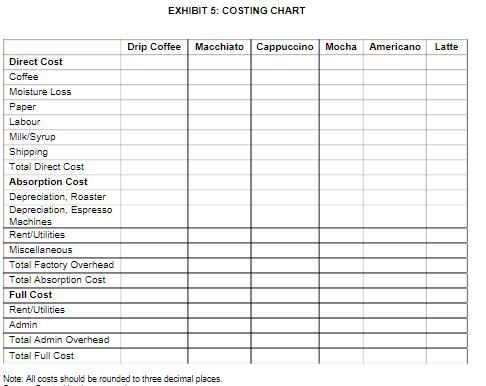Answered step by step
Verified Expert Solution
Question
1 Approved Answer
Fire Roasted primarily used a specialty blend, Saint Drogo, for its classic drip coffee. Saint Drogo was made with 40 per cent Brazilian beans, 30
Fire Roasted primarily used a specialty blend, Saint Drogo, for its classic drip coffee. Saint Drogo was
made with 40 per cent Brazilian beans, 30 per cent Peruvian beans, and 30 per cent Costa Rican beans. Fire
Fire Roasted primarily used a specialty blend, Saint Drogo, for its classic drip coffee. Saint Drogo was made with 40 per cent Brazilian beans, 30 per cent Peruvian beans, and 30 per cent Costa Rican beans. Fire Roasted also had an espresso blend called Expression, which was made up equally from five different beans: Brazilian, Ethiopian, Mexican, Nicaraguan, and Peruvian. The Expression blend was used to make all espresso-based beverages (see Exhibit 3).
The green, pre-roasted beans were purchased at different rates, in bags weighing 55 pounds (see Exhibit 4).7 However, the beans lost moisture when they were roasted, so each of these bags produced 15 per cent less roasted coffee by weight. Fire Roasted used one ounce of roasted coffee beans for a small cup of brewed coffee and one-half ounce of beans for a single ounce of espresso.8 The dairy-based coffee beverages used milk, which cost $0.035 per ounce. The chocolate syrup included in the mocha had a cost of $0.50 per cup. Fire Roasted used two coffee bean roasters for all its roasting needs. Each roaster had an original cost of $15,000 with no residual value. The roasters were depreciated using the units of production method, where each machine had an expected useful life of 12,000 hours. Cook hired workers to oversee the roasting process; they were each paid $15 per hour and could process two bags of green beans per hour (one bag per machine).
Once the beans were roasted, they were ground and served to customers in their drinks of choice. All coffee beverages were served in paper cups printed with the Fire Roasted logo, sleeves to keep customers from burning their hands, and plastic lids, for a total cost of $0.15 per drink.
The remainder of Fire Roasted’s costs were estimated based on the expenses and the amount of coffee sold in the previous fiscal year.
After purchasing a cup of coffee, customers were free to add dairy and sugar to their beverages. Regardless of the beverage, customers chose to add $0.005 worth of sugar to their cups on average. Dairy was typically added to purchases of drip coffee only and cost about $0.055 per cup. Cook considered the milk and sugar costs to be a part of the factory overhead costs.
Cook estimated that utilities and rent costs could be broken down to $0.30 per cup of coffee.9 Miscellaneous costs such as coffee disposal fees, cleaning supplies, and barista wages totalled $0.35 per cup, regardless of the beverage purchased. The depreciation cost of the espresso machine, on a per-cup basis, was $0.01; the depreciation for the drip coffee machine was determined to be negligible. Administration overhead costs, including Cook’s salary, added $0.17 to the cost of a cup of coffee, regardless of the beverage purchased.
With all the numbers in front of him, Cook began organizing his company’s costs. He questioned which type of cost might be most useful for making his pricing decision: direct cost, absorption cost, or full cost. Cook planned to calculate each of these costs for the six products he was considering for price changes. He sat down with an Americano and prepared to analyze his costs and decide on the most appropriate prices for these products.
EXHIBIT 3: BREAKDOWN OF INGREDIENTS FOR SELECT BEVERAGES
Latte: ten ounces of steamed milk; two ounces of espresso
Cappuccino: two ounces of foamed milk; two ounces of steamed milk; two ounces of espresso Macchiato: dot of foamed milk; two ounces of espresso
Americano: three ounces of hot water; two ounces of espresso
Mocha one ounce of steamed milk; two ounces of chocolate syrup; two ounces of espresso
DO the Cost charge for the company.
made with 40 per cent Brazilian beans, 30 per cent Peruvian beans, and 30 per cent Costa Rican beans. Fire
Fire Roasted primarily used a specialty blend, Saint Drogo, for its classic drip coffee. Saint Drogo was made with 40 per cent Brazilian beans, 30 per cent Peruvian beans, and 30 per cent Costa Rican beans. Fire Roasted also had an espresso blend called Expression, which was made up equally from five different beans: Brazilian, Ethiopian, Mexican, Nicaraguan, and Peruvian. The Expression blend was used to make all espresso-based beverages (see Exhibit 3).
The green, pre-roasted beans were purchased at different rates, in bags weighing 55 pounds (see Exhibit 4).7 However, the beans lost moisture when they were roasted, so each of these bags produced 15 per cent less roasted coffee by weight. Fire Roasted used one ounce of roasted coffee beans for a small cup of brewed coffee and one-half ounce of beans for a single ounce of espresso.8 The dairy-based coffee beverages used milk, which cost $0.035 per ounce. The chocolate syrup included in the mocha had a cost of $0.50 per cup. Fire Roasted used two coffee bean roasters for all its roasting needs. Each roaster had an original cost of $15,000 with no residual value. The roasters were depreciated using the units of production method, where each machine had an expected useful life of 12,000 hours. Cook hired workers to oversee the roasting process; they were each paid $15 per hour and could process two bags of green beans per hour (one bag per machine).
Once the beans were roasted, they were ground and served to customers in their drinks of choice. All coffee beverages were served in paper cups printed with the Fire Roasted logo, sleeves to keep customers from burning their hands, and plastic lids, for a total cost of $0.15 per drink.
The remainder of Fire Roasted’s costs were estimated based on the expenses and the amount of coffee sold in the previous fiscal year.
After purchasing a cup of coffee, customers were free to add dairy and sugar to their beverages. Regardless of the beverage, customers chose to add $0.005 worth of sugar to their cups on average. Dairy was typically added to purchases of drip coffee only and cost about $0.055 per cup. Cook considered the milk and sugar costs to be a part of the factory overhead costs.
Cook estimated that utilities and rent costs could be broken down to $0.30 per cup of coffee.9 Miscellaneous costs such as coffee disposal fees, cleaning supplies, and barista wages totalled $0.35 per cup, regardless of the beverage purchased. The depreciation cost of the espresso machine, on a per-cup basis, was $0.01; the depreciation for the drip coffee machine was determined to be negligible. Administration overhead costs, including Cook’s salary, added $0.17 to the cost of a cup of coffee, regardless of the beverage purchased.
With all the numbers in front of him, Cook began organizing his company’s costs. He questioned which type of cost might be most useful for making his pricing decision: direct cost, absorption cost, or full cost. Cook planned to calculate each of these costs for the six products he was considering for price changes. He sat down with an Americano and prepared to analyze his costs and decide on the most appropriate prices for these products.
EXHIBIT 3: BREAKDOWN OF INGREDIENTS FOR SELECT BEVERAGES
Latte: ten ounces of steamed milk; two ounces of espresso
Cappuccino: two ounces of foamed milk; two ounces of steamed milk; two ounces of espresso Macchiato: dot of foamed milk; two ounces of espresso
Americano: three ounces of hot water; two ounces of espresso
Mocha one ounce of steamed milk; two ounces of chocolate syrup; two ounces of espresso
DO the Cost charge for the company.


EXHIBIT 4: GREEN BEAN COFFEE PRICES (IN CA$) Origin Costa Rica Brazil Peru Mexico Nicaragua Ethiopia Price per Pound $3.32 $2.97 $3.57 $3.27 $3.52 $3.17
Step by Step Solution
★★★★★
3.50 Rating (160 Votes )
There are 3 Steps involved in it
Step: 1
To calculate the cost per cup of coffee for Fire Roasted we need to consider the various costs involved in the production of each beverage Lets break ...
Get Instant Access to Expert-Tailored Solutions
See step-by-step solutions with expert insights and AI powered tools for academic success
Step: 2

Step: 3

Ace Your Homework with AI
Get the answers you need in no time with our AI-driven, step-by-step assistance
Get Started


